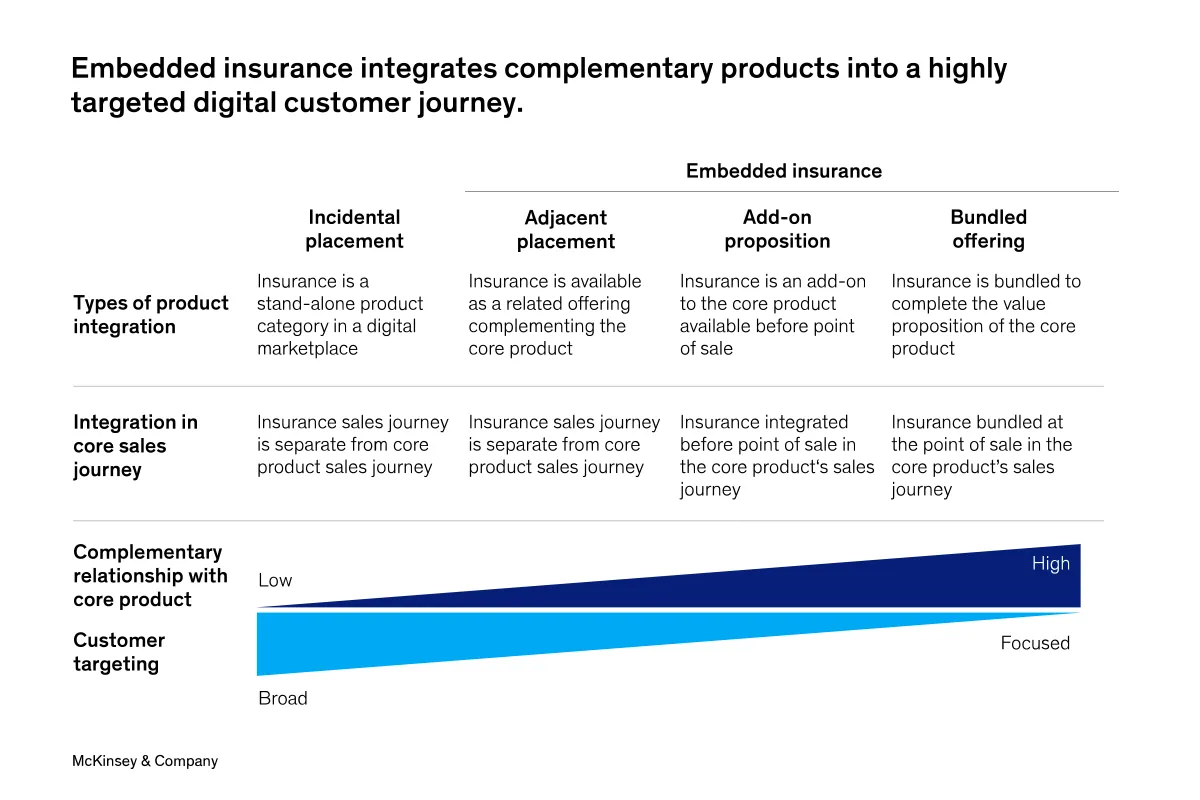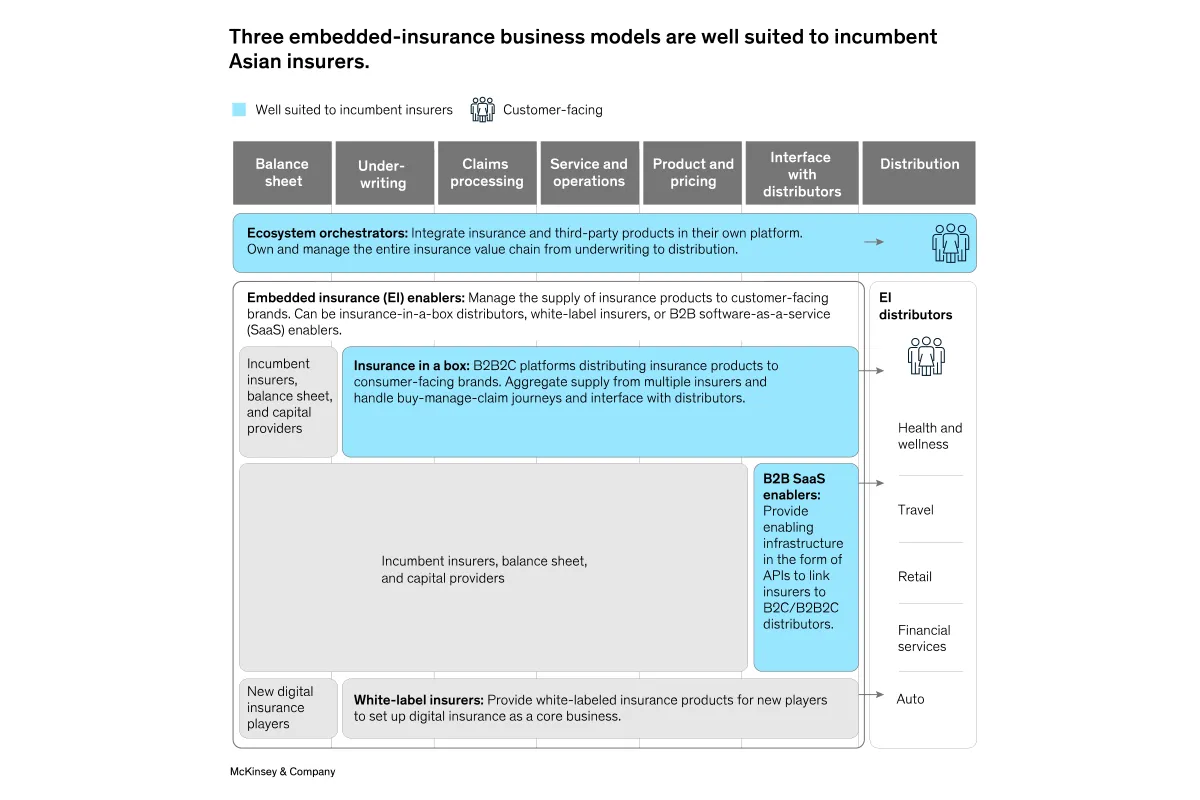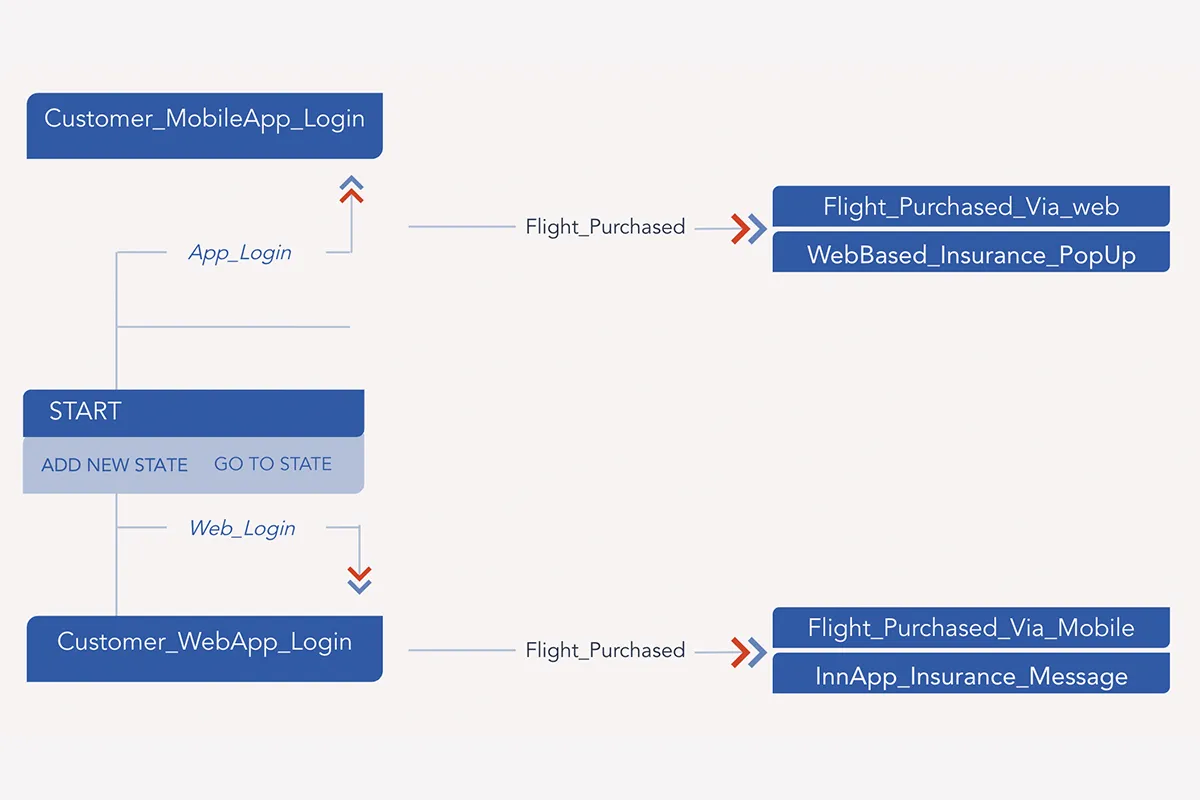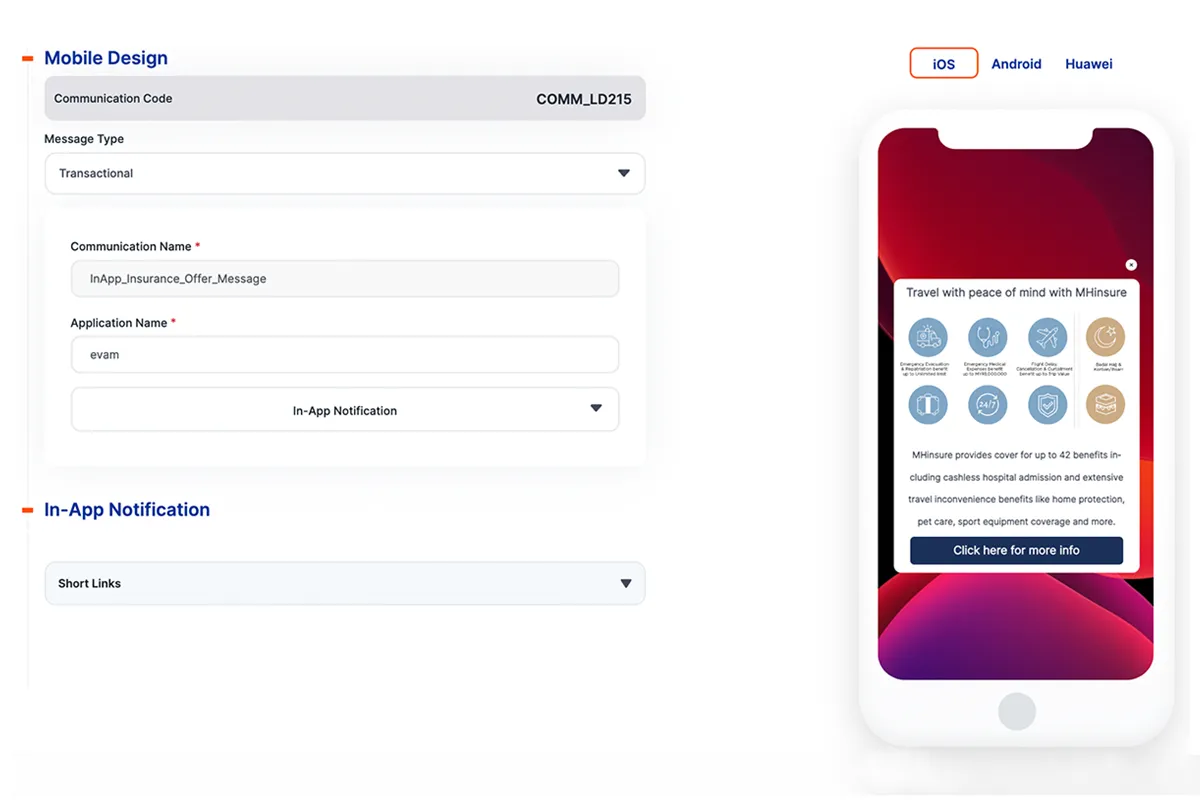Table of Contents
- Understanding Current Challenges of Traditional Insurance Models
- Embedded Insurance: Definitions and Applications
- Benefits of Embedded Insurance
- Implementing Embedded Insurance with Different Business Models
- Ecosystem Orchestrators
- Insurance in a Box
- B2B SaaS Enablers
- Embedded Insurance Case Studies to Get Inspired
- Trov and Lloyds Banking Group – Embedded Insurance for On-Demand Coverage
- JetBlue and Allianz – Embedded Travel Insurance for Customers
- Streamlining Embedded Insurance with Evam
- Let’s Join Forces to Redefine the Ultimate Customer Experience in the Insurance Industry
Insurance is a fast-changing and competitive industry, requiring industry players to advance in two main areas: creating differentiation by delivering the ultimate customer experience and keeping up with digital transformation.
Currently, 42% of customers within the insurance industry value seamless omnichannel experiences that entail various channels. However, traditional insurance models are too limited to provide this ultimate customer journey.

Embedded insurance is tackling this challenge by enabling insurance companies to deliver personalized and streamlined experiences that offer insurance products as a component of a connected journey through digital channels.
It is expected that embedded insurance will make up more than 30% of all insurance transactions by 2028, showing that it is one of the innovations industry players need to adopt to maintain a competitive advantage.
To assist you in acquiring an embedded approach toward delivering insurance products and services, this blog post will take an in-depth look into what embedded insurance is and share insightful examples to keep you inspired.
Understanding Current Challenges of Traditional Insurance Models
Embedded insurance is a straightforward concept, but understanding its importance lies in recognizing its distinctions from traditional approaches.
The conventional insurance models revolve around selling standalone products through intermediaries like agents, brokers, or comparison websites. However, these models present several limitations and challenges:
Inflexible Products: Insurance products are typically standardized and lack flexibility, making it difficult for customers to tailor policies to their specific needs.
Limited Distribution Channels: Conventional insurers heavily rely on agents or brokers for distribution, restricting their direct access to specific geographic regions or customer segments.
Low Customer Engagement: Typically, customers’ interactions with their insurers only happen when they buy a policy or make a claim. This minimal interaction with customers leads to a lack of engagement and understanding of customer preferences.
Disconnected Ecosystems: Integration with other industries may prove challenging for traditional insurers, hindering their ability to provide insurance solutions at relevant touchpoints in their customers’ lives.
By embracing an embedded approach, companies can overcome these challenges and offer more customized, accessible, and engaging insurance experiences to their customers.
Embedded Insurance: Definitions and Applications
Embedded insurance involves seamlessly integrating insurance products or coverage into non-insurance products or services, creating a unified offering for customers.
By doing so, the insurance component becomes an integral part of the main product or service, providing added value and protection without the need for customers to buy a separate insurance policy.
Embedded insurance integrates complementary products into a highly targeted digital customer journey.
Source: McKinsey & Company
Partnership lies at the heart of this innovative and customer-centric approach. It requires businesses and insurance companies to collaborate to embed relevant insurance offerings directly into products or services.
Embedded insurance to customer journeys can be highly promising for industries where providing a hyper-targeted customer experience is the main differentiating factor—especially for industries like Financial Services, Telecommunication, and Aviation & Transportation.
Benefits of Embedded Insurance
The embedded approach offers insurance customers a connected journey, addressing their needs in real-time. This enables insurance companies to deliver the right offering at the right moment and through the appropriate message, turning every interaction into a positive customer experience. It can also provide several benefits for both customers in the market and insurers, such as:
Contextual Relevance: The insurance coverage is directly related to the use or purchase of the main product or service, making it highly relevant to the customer’s needs.
Personalization: Policies or insurance coverage can be customized to each customer’s preferences and circumstances, providing a more engaging experience.
Real-time Activation: Insurance coverage is automatically activated when the customer uses or purchases the main product or service, ensuring immediate protection and peace of mind.
Simplified Claims Process: Integrated systems and data sharing streamline the claims process, reducing the administrative burden on the customer.
New Revenue Streams: Insurance companies can tap into non-traditional markets thanks to digital channels. This creates new revenue streams and business opportunities for insurers.
Actionable Insights: An embedded system requires utilizing real-time interaction management in the insurance operations. This approach entails leveraging data analytics to gain insights into customer behavior and risk profiles, enabling more accurate underwriting and risk management.
These benefits tackle the current challenges of conventional insurance by offering more flexible and personalized products that can be seamlessly integrated with various services.
Currently, 50% of customers place a high value on this level of personalization, but only 17% of insurers prioritize delivering individual experiences to their customers. Therefore, there is a huge opportunity for companies that utilize embedded insurance to capitalize on the next big opportunities.
Implementing Embedded Insurance with Different Business Models
Embedded insurance presents an exciting opportunity for incumbent insurers to capitalize on their core strengths in product development, pricing, underwriting, claims management, and service operations to thrive in the market.
Three business models that can benefit incumbent insurers are ecosystem orchestrators, insurance in a box, and B2B SaaS enablers.

Source: McKinsey & Company
Let’s take a deeper look into how these business models can function for companies that aim to unlock greater customer engagement in the insurance industry.
Ecosystem Orchestrators
One prominent approach to embedded insurance is the Ecosystem Orchestrator model. Under this model, insurers seamlessly integrate their insurance offerings with third-party products within their existing platform.
By taking ownership of the entire insurance value chain, including underwriting, claims management, service operations, product development, and pricing, these insurers can create a seamless and efficient user experience for their customers.
Insurance in a Box
Another compelling business model is known as "Insurance in a Box." Here, B2B2C platforms collaborate with insurers to distribute insurance products to consumer-facing brands.
These platforms aggregate supply from multiple insurers and facilitate end-to-end digital journeys for customers, from purchasing policies to managing claims.
B2B SaaS Enablers
The B2B SaaS Enabler model involves providing Application Programming Interfaces (APIs) that link insurers directly to distributors. These APIs serve as the interface through which insurers and distributors interact with and jointly serve the end customers.
This model differs from "Insurance in a Box" where the B2B2C platform partner handles all post-purchase customer interactions and coordinates with the insurer in the background.
Embedded Insurance Case Studies to Get Inspired
Trov and Lloyds Banking Group – Embedded Insurance for On-Demand Coverage
In a groundbreaking partnership, Trov, the leading insurance company, teamed up with Lloyds Banking Group to offer on-demand insurance coverage for personal belongings such as gadgets, electronics, and valuables.
Lloyds Banking Group integrated Trov’s on-demand insurance platform into their banking services, making it easy for customers to access coverage through their banking app. Through this user-friendly mobile app, customers could purchase insurance when needed. The results were impressive:
New Revenue Streams: Lloyds Banking Group expanded beyond traditional banking services, generating new revenue by offering on-demand insurance.
Customer Engagement: The embedded insurance offering increased customer engagement within the banking app, leading to higher customer retention and cross-selling opportunities.
Reduced Overhead: Trov’s technology streamlined insurance processes, leading to cost-effective operations for Lloyds Banking Group.
Enhanced Market Presence: The partnership with Trov allowed Lloyds Banking Group to tap into the insurtech market, expanding its product portfolio.
JetBlue and Allianz – Embedded Travel Insurance for Customers
Allianz partnered with JetBlue Airways to offer embedded travel insurance coverage for its customers when booking flights and other travel services.
JetBlue integrated Allianz’s insurance offerings into its booking platform, allowing customers to easily opt for travel insurance during the flight booking process.
The travel insurance coverage included protection for trip cancellations, trip interruptions, baggage loss, medical emergencies, and other travel-related incidents. This collaboration brought remarkable benefits such as:
Enhanced Customer Experience: The embedded travel insurance gave customers peace of mind, leading to higher customer satisfaction and loyalty.
Increased Revenue: JetBlue generated additional income by offering travel insurance as an add-on during bookings.
Risk Mitigation: Allianz’s insurance coverage helped minimize risks associated with travel for customers.
Brand Loyalty: The customer-focused approach of JetBlue and Allianz attracted more satisfied and loyal customers.
Streamlining Embedded Insurance with Evam
Evam’s real-time cross-channel martech platform, Evam Marketing Suite, enables insurance companies and key players from industries such as financial services and telecommunications organizations to streamline their embedded insurance efforts.
This easily integrable and security-compliant platform collects and analyzes actionable customer data and utilizes a data-driven approach to decision-making, ensuring that the right actions are taken in milliseconds.
Here is an example scenario you can create with Evam Marketing Suite, where the main aim is to remind users of the benefits of travel insurance and how they can easily purchase it.
 Evam Marketing Suite tracks whether the user has logged in via the mobile app or the website
Evam Marketing Suite tracks whether the user has logged in via the mobile app or the website(tracked by the "web login" and "app login" events).
In case a specific user has logged in, the platform checks if the user has purchased a plane ticket using the "flight_purchased" event.
If the user has purchased a plane ticket, Evam Marketing Suite triggers a mobile in-app message or a web push notification reminding them of the various benefits of travel insurance and providing information on how to purchase it.
Let’s look at another scenario Evam Marketing Suite can trigger for an insurance company. This scenario is defined to track the events of customers buying travel insurance and offering them extra miles.
Evam Marketing Suite checks if a user visits the travel insurance landing page.
If the customer clicks on the "buy now" button and arrives at the purchase page, the platform displays a web push notification to the customer offering extra miles.

Let’s Join Forces to Redefine the Ultimate Customer Experience in the Insurance Industry
Leveraging the power of embedded insurance requires utilizing a system capable of real-time interaction management.
As a leading martech company specializing in customer journey orchestration, we can help you create an omnichannel insurance strategy that delivers contextually relevant and personalized experiences to your customers.
Intrigued to learn how we can help you? Get in touch with us today!
Frequently Asked Questions (FAQ)
1. What is embedded insurance and how does it differ from traditional insurance models?
Embedded insurance refers to the seamless integration of insurance products into non-insurance services or purchases, offering protection and value without requiring a separate transaction. Unlike traditional insurance models that depend on intermediaries like brokers or comparison websites, embedded insurance delivers a more fluid and contextually relevant experience for the customer. It allows insurance to become a natural part of the customer journey, often activated in real time at the point of sale or engagement. This approach not only simplifies access but also ensures the insurance offering is personalized, timely, and aligned with the customer’s specific needs and activities.
2. Why is embedded insurance becoming a vital innovation in the insurance industry?
As consumer expectations continue to evolve, embedded insurance addresses growing demands for seamless, personalized, and omnichannel experiences. Research shows that by 2028, embedded insurance is expected to account for over 30% of all insurance transactions. This trend signals a shift in how insurance is delivered and consumed, giving companies a competitive edge through contextually relevant and efficient offerings. With customers valuing convenience and integrated experiences more than ever, embedded insurance is emerging as a key enabler of customer satisfaction and operational agility in a traditionally rigid industry.
3. What are the major challenges with conventional insurance models that embedded insurance helps solve?
Traditional insurance models are often characterized by rigid, standardized products and reliance on limited distribution channels, typically through brokers or agents. Customer engagement is minimal, usually restricted to purchasing or claiming, which hinders relationship-building. Moreover, integration with other sectors is cumbersome, limiting insurers’ ability to provide services where and when customers need them most. Embedded insurance mitigates these issues by offering flexible, relevant coverage within digital ecosystems, creating more frequent touchpoints and improving both accessibility and customer experience.
4. How does embedded insurance enhance the customer experience?
Embedded insurance enriches the customer journey by offering personalized, timely, and frictionless insurance coverage at moments that matter. Whether it's purchasing travel insurance during a flight booking or protecting a newly bought gadget through a banking app, the embedded model ensures relevance and convenience. Real-time activation, simplified claims processes, and the ability to tailor coverage based on individual behaviors all contribute to higher satisfaction. Furthermore, the use of data analytics enhances accuracy in underwriting and allows for more insightful risk management.
5. What business models support the implementation of embedded insurance?
There are three primary business models through which insurers can adopt embedded insurance: the Ecosystem Orchestrator, Insurance in a Box, and B2B SaaS Enabler. The Ecosystem Orchestrator model allows insurers to integrate their offerings directly within third-party platforms while managing the full insurance value chain. Insurance in a Box involves B2B2C platforms distributing insurer products to end consumers, streamlining policy management and claims. The B2B SaaS Enabler model focuses on providing APIs to distributors, facilitating direct, real-time collaboration between insurers and partners. Each model allows insurers to diversify their reach and meet customers where they are.
6. How do case studies like Trov and Lloyds Banking Group demonstrate the power of embedded insurance?
The collaboration between Trov and Lloyds Banking Group illustrates how embedded insurance can generate new revenue streams, enhance customer engagement, and reduce operational overhead. By integrating on-demand coverage into its banking app, Lloyds expanded its service offering and improved customer retention. Similarly, JetBlue’s partnership with Allianz integrated travel insurance into the booking process, leading to improved customer experience, increased ancillary revenue, and stronger brand loyalty. These examples highlight the tangible business value of offering relevant insurance products at critical customer moments.
7. How does embedded insurance benefit industries beyond insurance itself?
Industries such as financial services, telecommunications, and travel can leverage embedded insurance to enrich their offerings and differentiate themselves in competitive markets. For example, financial institutions can bundle device protection or travel insurance into their digital platforms, enhancing customer value. Telcos can offer theft or damage coverage with device purchases. These cross-sector collaborations increase customer stickiness and unlock new revenue opportunities by addressing risk needs directly within familiar customer journeys.
8. What role does Evam play in enabling embedded insurance?
Evam’s Martech platform, the Evam Marketing Suite, empowers insurers and other industry players to deliver real-time, omnichannel embedded insurance experiences. With capabilities such as event tracking, behavioral segmentation, and automated message delivery, Evam enables the creation of responsive and personalized insurance journeys. For instance, the platform can identify when a customer purchases a flight and immediately trigger an in-app reminder to explore travel insurance options. Similarly, it can reward users with bonus miles for purchasing insurance, driving engagement and conversion. These capabilities help insurers act within milliseconds, turning insights into timely and effective customer actions.








